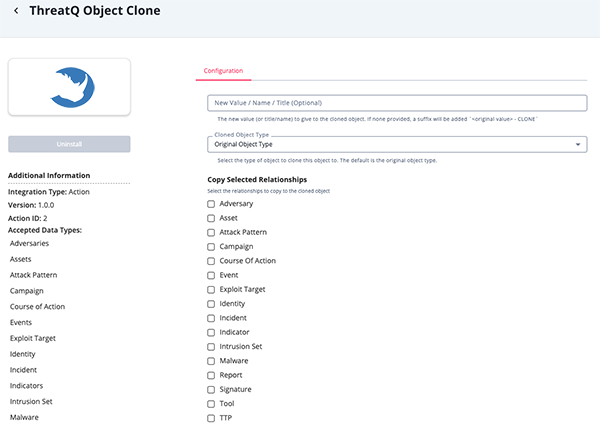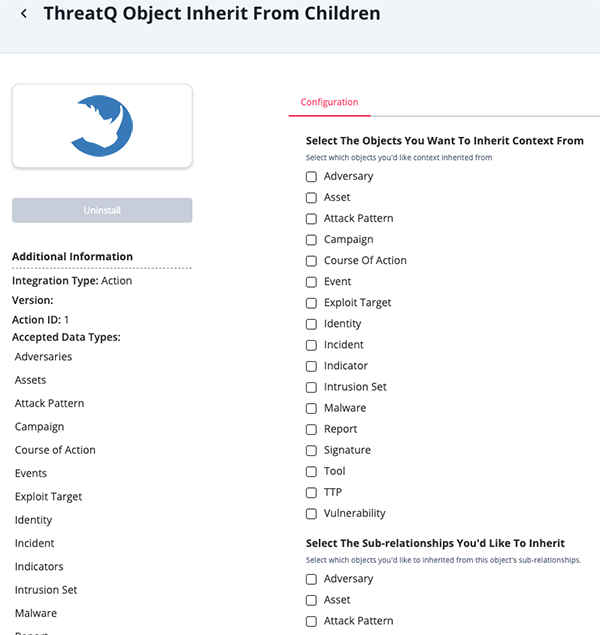ThreatQ Object Action Bundle
The web format of this guide reflects the most current release. Guides for older iterations are available in PDF format.
Integration Details
ThreatQuotient provides the following details for this integration:
| Current Integration Version | 1.0.0 |
| Compatible with ThreatQ Versions | >= 5.29.0 |
| ThreatQ TQO License Required | Yes |
| Support Tier | ThreatQ Supported |
Introduction
The ThreatQ Object Action for ThreatQ allows a user to interact with ThreatQ objects in complex ways to better manage the Threat Library.
The action can perform the following functions:
- ThreatQ Object Clone - create a new object based on the original.
- ThreatQ Object Inherit From Children - add relationships and other context from child relationships.
The action is compatible with the following system object types:
|
|
This action is intended for use with ThreatQ TDR Orchestrator (TQO). An active TQO license is required for this feature.
Prerequisites
- An active ThreatQ TDR Orchestrator (TQO) license.
- A data collection containing at least one of the following object types:
- Adversary
- Asset
- Attack Pattern
- Campaign
- Course Of Action
- Event
- Exploit Target
- Identity
- Incident
- Indicator
- Intrusion Set
- Malware
- Report
- Signature
- Tool
- TTP
- Vulnerability
Installation
Perform the following steps to install the integration:
The same steps can be used to upgrade the integration to a new version.
- Log into https://marketplace.threatq.com/.
- Locate and download the action zip file.
- Navigate to the integrations management page on your ThreatQ instance.
- Click on the Add New Integration button.
- Upload the action zip file using one of the following methods:
- Drag and drop the zip file into the dialog box
- Select Click to Browse to locate the zip file on your local machine
ThreatQ will inform you if the action already exists on the platform and will require user confirmation before proceeding. ThreatQ will also inform you if the new version of the action contains changes to the user configuration. The new user configurations will overwrite the existing ones for the action and will require user confirmation before proceeding.
You will still need to configure the actions.
Configuration
ThreatQuotient does not issue API keys for third-party vendors. Contact the specific vendor to obtain API keys and other integration-related credentials.
To configure the integration:
- Navigate to your integrations management page in ThreatQ.
- Select the Actions option from the Category dropdown (optional).
- Click on the action entry to open its details page.
- Enter the following parameters under the Configuration tab:
The configurations set on this page will be used as the default settings when inserting this action into a new workflow. Updating the configurations on this page will not update any instances of this action that have already been deployed to a workflow. In that scenario, you must update the action’s configurations within the workflow itself.
ThreatQ Object Clone Parameters
Parameter Description New Value / Name / Title (Optional) The new value (or title/name) to give to the cloned object. If none provided, a prefix will be added. Example: <original value> - CLONE.Cloned Object Type Select the type of object to clone this object to. The default is the original object type. Options include: - Adversary
- Asset
- Attack Pattern
- Campaign
- Course Of Action
- Event
- Exploit Target
- Identity
- Incident
- Indicator
- Intrusion Set
- Malware
- Report
- Signature
- Tool
- TTP
- Vulnerability
Copy Selected Relationships Select the relationships to copy to the cloned object. Options include: - Adversary
- Asset
- Attack Pattern
- Campaign
- Course Of Action
- Event
- Exploit Target
- Identity
- Incident
- Indicator
- Intrusion Set
- Malware
- Report
- Signature
- Tool
- TTP
- Vulnerability
Copy Descriptions Enable this to copy all the descriptions to the cloned object. Copy Tags Enable this to copy all tags to the cloned object. Copy Attributes Enable this to copy all attributes (including their sources) to the cloned object. Relate Cloned Object to Original Enable this to relate the cloned object to the original object. Objects per run Maximum number of objects per-run.

ThreatQ Object Inherit from Children Parameters
Parameter Description Select the objects you want to inherit context from Select which objects you'd like context inherited from. Select the sub-relationships you'd like to inherit Select which objects you'd like to inherited from this object's sub-relationships. Inherit Tags Check this to bubble up tags to this object Inherit Attributes Check this to bubble up attributes to this object Objects per run Maximum number of objects per-run.

- Review any additional settings, make any changes if needed, and click on Save.
Enriched Data
Object counts and action runtime are supplied as generalities only - objects returned by a provider can differ based on credential configurations and action runtime may vary based on system resources and load.
ThreatQ Object Clone
| Metric | Result |
|---|---|
| Run Time | 1 minute |
| Adversaries | 100 |
| Adversary Attributes | 260 |
| Reports | 100 |
| Report Attributes | 420 |
ThreatQ Object Inherit from Children
| Metric | Result |
|---|---|
| Run Time | 1 minute |
| Adversaries | 100 |
| Adversary Attributes | 260 |
| Reports | 100 |
| Report Attributes | 420 |
Use Case Example
ThreatQ Object Clone
- A user submits a collection of Adversaries that have tags, attributes, descriptions and other related objects.
- The user sets
Cloned Object TypetoReportand checks the information that should be added to the new reports from the adversaries. - The action creates a new Report based on the original Adversary.
ThreatQ Object Inherit from Children
- A user submits a collection of Adversaries that have related objects
- The action enriches each Adversary with information from the related objects according to the user configuration.
Known Issues / Limitations
- The
ThreatQ Object Cloneaction cannot create objects that have a required type (Indicators, Events) or status (Indicators) if the original object that not also have it.
Change Log
- Version 1.0.0
- Initial release
PDF Guides
| Document | ThreatQ Version |
|---|---|
| ThreatQ Object Action Bundle Guide v1.0.0 | 5.29.0 or Greater |